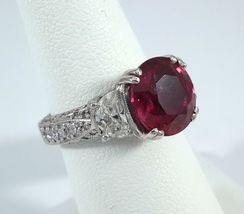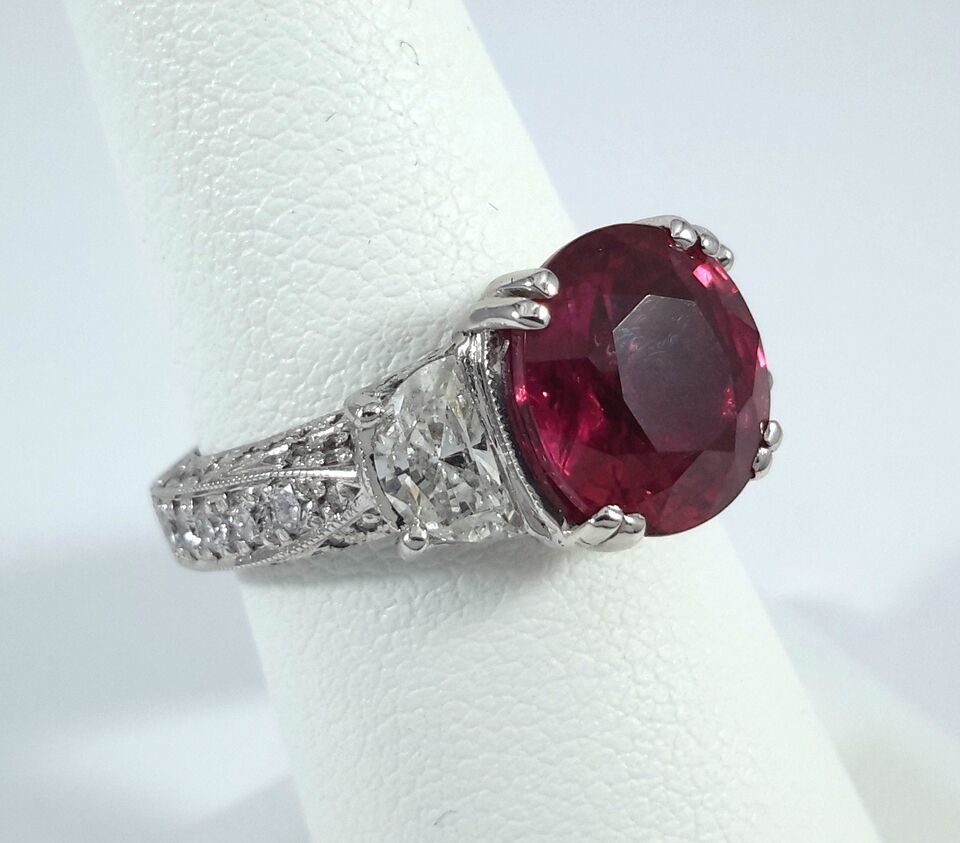Rendered at 15:20:27 05/04/25
Free Shipping
(GIA CERT) 4.49ct East African RUBY Ring - R9214
$16,500.00
Shipping options
Seller handling time is 3 business days Details
FREE in United States
Offer policy
OBO - Seller accepts offers on this item.
Details
Return policy
None: All purchases final
Purchase protection
Payment options
PayPal accepted
PayPal Credit accepted
Venmo accepted
PayPal, MasterCard, Visa, Discover, and American Express accepted
Maestro accepted
Amazon Pay accepted
Nuvei accepted
Shipping options
Seller handling time is 3 business days Details
FREE in United States
Offer policy
OBO - Seller accepts offers on this item.
Details
Return policy
None: All purchases final
Purchase protection
Payment options
PayPal accepted
PayPal Credit accepted
Venmo accepted
PayPal, MasterCard, Visa, Discover, and American Express accepted
Maestro accepted
Amazon Pay accepted
Nuvei accepted
Item traits
| Category: | |
|---|---|
| Quantity Available: |
2 in stock |
| Condition: |
New with tags |
| Brand: |
Unbranded |
| Main Stone: |
Ruby |
| Metal: |
White Gold |
| Metal Purity: |
14k |
| Ring Size: |
6.5 |
| Type: |
Gemstone |
| Secondary Stone: |
Diamond |
| Main Stone Color: |
Red |
| Style: |
With Diamonds & Gemstones |
| Main Stone Shape: |
Oval |
| Main Stone Creation: |
Natural |
| Main Stone Treatment: |
Heating |
| Sizable: |
Yes |
| Jewelry Type: |
Ring |
| Total Carat Weights: |
Listing details
| Seller policies: | |
|---|---|
| Shipping discount: |
Seller pays shipping for this item. |
| Posted for sale: |
More than a week ago |
| Item number: |
1722141666 |
Item description
GIA Certified Ruby/Diamond Ring
This Amazing ring has a Oval cut center RUBY stone certificate by GIA 6173091572
4.49ct African Red Ruby
1.57ct total weight diamonds.
and is crafted in 14k white gold.
*certificate is for stone only
Ruby
Ruby
General
Category
Oxide mineral variety
Formula
(repeating unit)
aluminium oxide with chromium, Al2O3:Cr
Crystal system
Trigonal
Identification
Color
Near colorless through pink through all shades of red to a deep crimson
Crystal habit
Terminated tabular hexagonal prisms.
Luster
Subadamantine, vitreous,
A
ruby is a pink to blood-red colored gemstone, a variety of the mineral
corundum (aluminium oxide). Other varieties of gem-quality corundum are
called sapphires. Ruby is one of the traditional cardinal gems, together
with amethyst, sapphire, emerald, and diamond.[3] They word ruby comes
from ruber, Latin for red. The color of a ruby is due to the element
chromium.
The quality of a ruby is determined by its color, cut,
and clarity, which, along with carat weight, affect its value. The
brightest and most valuable shade of red called blood-red or pigeon
blood, commands a large premium over other rubies of similar quality.
After color follows clarity: similar to diamonds, a clear stone will
command a premium, but a ruby without any needle-like rutile inclusions
may indicate that the stone has been treated. Ruby is the traditional
birthstone for July and is usually more pink than garnet, although some
rhodolite garnets have a similar pinkish hue to most rubies. The world's
most expensive ruby is the Sunrise Ruby.
Physical properties
Crystal structure of rubies
Rubies have a hardness of 9.0 on the Mohs scale of mineral
hardness. Among the natural gems only moissanite and diamond are harder,
with diamond having a Mohs hardness of 10.0 and moissanite falling
somewhere in between corundum (ruby) and diamond in hardness. Sapphire,
ruby, and pure corundum are alumina, the most stable form of Al2O3, in
which 3 electrons leave each aluminum ion to join the regular
octahedral group of six nearby O2 ions; in pure corundum this leaves
all of the aluminum ions with a very stable configuration of no unpaired
electrons or unfilled energy levels, and the crystal is perfectly
colorless.
When a chromium atom replaces an occasional aluminum
atom, it too loses 3 electrons to become a chromium3+ ion to maintain
the charge balance of the Al2O3 crystal. However, the Cr3+ ions are
larger and have electron orbitals in different directions than aluminum.
The octahedral arrangement of the O2 ions is distorted, and the energy
levels of the different orbitals of those Cr3+ ions are slightly
altered because of the directions to the O2 ions.[4] Those energy
differences correspond to absorption in the ultraviolet, violet, and
yellow-green regions of the spectrum.
Transmittance of ruby in optical and near-IR spectra. Note the two broad
violet and yellow-green absorption bands and one narrow absorption band
at the wavelength of 694 nm, which is the wavelength of the ruby laser.
If one percent of the aluminum ions are replaced by chromium in
ruby, the yellow-green absorption results in a red color for the gem.[4]
Additionally, absorption at any of the above wavelengths stimulates
fluorescent emission of 694-nanometer-wavelength red light, which adds
to its red color and perceived luster.
After absorbing
short-wavelength light, there is short interval of time when the crystal
lattice of ruby is in an excited state before fluorescence occurs. If
694-nanometer photons pass through the crystal during that time, they
can stimulate more fluorescent photons to be emitted in-phase with them,
thus strengthening the intensity of that red light. By arranging
mirrors or other means to pass emitted light repeatedly through the
crystal, a ruby laser in this way produces a very high intensity of
coherent red light.
All natural rubies have imperfections in
them, including color impurities and inclusions of rutile needles known
as "silk". Gemologists use these needle inclusions found in natural
rubies to distinguish them from synthetics, simulants, or substitutes.
Usually, the rough stone is heated before cutting. These days, almost
all rubies are treated in some form, with heat treatment being the most
common practice. Untreated rubies of high quality command a large
premium.
Some rubies show a three-point or six-point asterism or
"star". These rubies are cut into cabochons to display the effect
properly. Asterisms are best visible with a single-light source and move
across the stone as the light moves or the stone is rotated. Such
effects occur when light is reflected off the "silk" (the structurally
oriented rutile needle inclusions) in a certain way. This is one example
where inclusions increase the value of a gemstone. Furthermore, rubies
can show color changes though this occurs very rarely as well as
chatoyancy or the "cat's eye" effect.
Ruby vs. pink sapphire
Generally,
gemstone-quality corundum in all shades of red, including pink, are
called rubies.[5][6] However, in the United States, a minimum color
saturation must be met to be called a ruby; otherwise, the stone will be
called a pink sapphire.[5] Drawing a distinction between rubies and
pink sapphires is relatively new, having arisen sometime in the 20th
century. Often, the distinction between ruby and pink sapphire is not
clear and can be debated.[7] As a result of the difficulty and
subjectiveness of such distinctions, trade organizations such as the
International Colored Gemstone Association (ICGA) have adopted the
broader definition for ruby which encompasses its lighter shades,
including pink.[8][9]in a red color for the gem.[4]
Added to your wish list!

- (GIA CERT) 4.49ct East African RUBY Ring - R9214
- 2 in stock
- Available in multiple total carat weights
- Price negotiable
- Handling time 3 days.
Get an item reminder
We'll email you a link to your item now and follow up with a single reminder (if you'd like one). That's it! No spam, no hassle.
Already have an account?
Log in and add this item to your wish list.

















